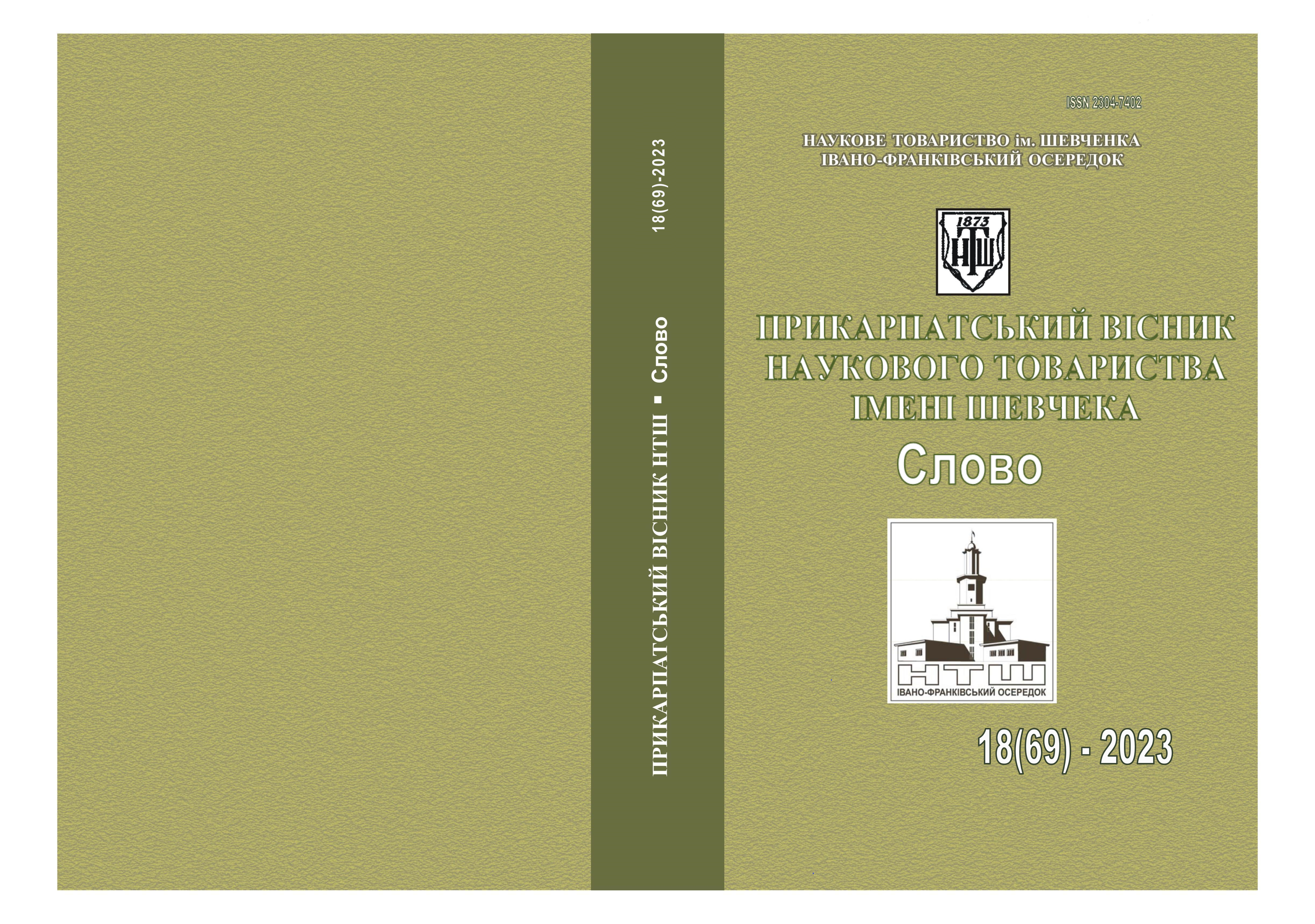VERBALIZATION OF THE AUSTRIAN MYTH IN THE STANISLAV VINCENZ’S TETRALOGY “IN THE UPPER HIGHLANDS”
DOI:
https://doi.org/10.31471/2304-7402-2023-18(69)-336-348Keywords:
мовна комунікація, літературна критика, австрійський міт, польська література, Станіслав Вінценз.Abstract
The purpose of the article is to find out the specifics of the verbalization of the Austrian myth in S. Vincenz’s tetralogy “In the Upper Highlands”. The author is convinced that the mytho-critical interpretation of the work of the outstanding Polish humanist writer will contribute to the modern analysis of the idea of the tetralogy “In the Upper Highlands” at the ideological level, its correlation with the plot, genre features, and character. To implement this research problem, the author used interpretative, comparative-typological methods, myth-critical and cultural-historical approaches.
The results. The verbalization of the Austrian myth in S. Vincenz’s tetralogy “In the Upper Highlands” is explained by biographical, historical, ethnic and cultural factors that influenced the work of the writer, a native of late Habsburg Galicia, in particular the Pokuttia-Hutsul borderland. The interaction of these factors created the basis for an artistic description of an imaginary and artificial model of everyday ethnic groups of Hutsul region and Pokuttia within the borders of Austria-Hungary, its original virtualization. The Austrian myth in S. Vincenz’s epic novel is not equivalent to fiction, the author's fantasy, but its elements (the person of the emperor, the imperial army, ethnic groups) are evidence of the author’s subjective vision of the region after the collapse of the Habsburg monarchy in 1918, the post-war (after the WWІ) actualization of idealization of multinational space and fictionalization of reality. The specificity of the Austrian myth of S. Vincenz’s texts is that the first volume of S. Vincenz’s tetralogy was published in 1936 in Warsaw, and the following volumes were published in London in 1970, 1974, and 1979, respectively (the last two – after the author’s death), which testifies to the “two-dimensionality” of the writer's mythological thinking – in the interwar period and in the post-war period (after forced emigration and WWII), where time and space overlapped to a certain extent on S. Vincenz’s work.
The scientific novelty of the study – the mytho-critical reading of S. Vincenz’s tetralogy “In the Upper Highlands” made it possible to supplement the overall picture of the author’s worldview of a certain cultural and historical era – the interwar (1920-1930s) and post-war (after 1945) periods. The identification of the elements of the Austrian myth, its verbalization by S. Vincenz significantly complements the methodology of the analysis of artistic works, their literary criticism.
The practical significance of the article is that its main provisions can be used for further studies on the problems of the Austrian myth in world and Ukrainian literature of the 20th and early 21st centuries, and generalized for further modeling of the myth-critical analysis of the texts of the representatives of the Austrian myth – natives of modern Ukraine.
References
Барт Р. Від твору до тексту; пер. Ю. Ґудзя. Антологія світової літературно-критичної думки ХХ ст. 2-е вид., доп. За ред. М. Зубрицької. Львів: Літопис, 2002. С. 491-496.
Вінценз С. На високій полонині. Том І: Правда старовіку; пер. з пол. Т. Прохасько. Івано-Франківськ: Лілея-НВ, 2018. 544 с.
Вінценз С. На високій полонині. Книга ІІ: Нові часи (Чвари); пер. з пол. В. Павлів. Харків: Фоліо, 2019. 731 с.
Вінценз С. На високій полонині. Книга ІІ: Нові часи (Листи з неба); пер. з пол. В. Павлів. Харків: Фоліо, 2022. 667 с.
Гаврилів Т. Шкіц філософії сум’яття. Австрійська література у ХІХ і ХХ сторіччях. Львів: ВНТЛ-Класика, 2011. 354 с.
Еко У. Роль читача. Дослідження з семіотики текстів; пер. з англ. М. Гірняк. Львів: Літопис, 2004. 384 с.
Єндик Р. Станислав Вінценз – співець Гуцульщини. Наукові записки УТГІ. [Т.] XXIII. Мюнхен, 1971-1972. С. 48-80.
Леві-Строс К. Структурна антропологія; пер. з фр. З. Борисюк. Київ: Основи, 2000. 387 с.
Олдаковська-Куфель М. Станіслав Вінценз: письменник, гуманіст, речник зближення народів. Біографія; пер. з пол. О. Герасима. Чернівці: Книги-ХХІ, 2012. 512 с.
Хороб С. Особливості міфологічного мислення Станіслава Вінценза (на матеріалі роману-епопеї «На високій полонині»). Вінцензіана. Статті, листи, фрагменти творів. За ред. М. Васильчука. Коломия: Вік, 2008. С. 104-113.
Cybenko L. Galicia Miserabilis und/oder Galicia Felix? Ostgalizien in der österreichischen Literatur. Lwiw – Wien: VNTL-Klasyka; Praesens Verlag, 2008. 220 S.
Kaszyński S. H. W cieniu habsburskich krajobrazów. Trzynaście esejów o literaturze austriackiej. Poznań: Ars Nova, 2006. 239 s.
Klańska M. Daleko od Wiednia. Galicja w oczach pisarzy niemeckojęzycznych 1772–1918. Kraków: Universitas, 1991. 276 s.
Kolbuszewski J. Kresy. Wrocław: Wydawnictwo Dolnośląskie, 1997. 257 s.
Magris C. O demokracji, pamięci i Europie Środkowej. Wybór i przekład: Joanna Ugniewska. Kraków: Międzynarodowy Centrum Kultury, 2016. 365 s.
Woldan A. Austria w twórczości Stanisława Vincenza. Świat Vincenza. Studia o życiu i twórczości Stanisława Vincenza (1888–1971). Pod redakcją Jana A. Choroszego i Jacka Kolbuszewskiego. Wrocław: Leopoldinum, 1992. S. 127-133.
Woldan A. Mit Austrii w literaturze polskiej. Tłumaczenie Krzysztof Jachimczak, Ryszard Wojnakowski. Kraków: Międzynarodowy Centrum Kultury, 2002. 281 s.
Vincenz S. Na wysokiej połoninie. Obrazy, dumy i gawędy z wierchowiny huculskiej. Warszawa: Towarzystwo wydawnicze „Rój”, 1936. 720 s.
Vincenz S. Na Wysokiej Połoninie. Pasmo trzecie: Barwinkowy wianek. Londyn: Oficyna Poetów i Malarzy, 1979. 485 s.

